Pros
-
Excellent 120Hz display
-
Snappy processor
-
Lots of useful ports
The Lenovo IdeaPad Gaming Chromebook excels as a Chromebook but falls flat for gaming.
About the Lenovo IdeaPad Gaming Chromebook

Credit:
Reviewed / Adrien Ramirez
We tested the Intel Core i5-1235U version of this laptop; there’s also an Intel Core i3-1215U configuration.
Here are the specs of the laptop we tested:
- Processor: Intel Core i5-1235U
- Graphics: Integrated Intel Iris Xe graphics
- RAM: 8GB DDR4 memory
- Storage: 256GB SSD PCIe Gen 4
- Display: 2560 x 1600p @ 120Hz IPS display
- Ports: MicroSD card reader, USB-C 3.2 Gen 2 x 2, USB-A 3.2 Gen 1 x 2, Headphone jack
- Wireless connectivity: WiFi 6E, Bluetooth 5.1
- Camera: 1080p webcam with privacy shutter
- Battery: 71WHr
- Weight: 4.01 pounds
- Size: 0.79 x 14.03 x 9.96 inches
- Warranty: 1-year limited warranty
The Lenovo IdeaPad Gaming Chromebook is available in two configurations: one with an Intel Core i5-1235U and one with an Intel Core i3-1215U. We tested the Intel Core i5 version.
What we like
Great ergonomics
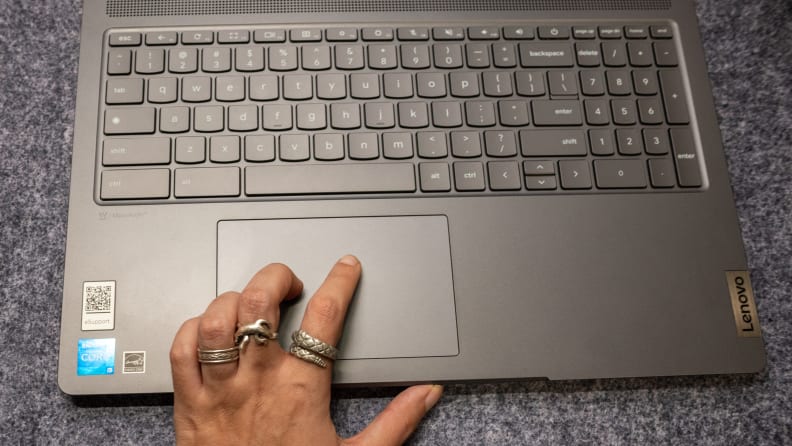
Credit:
Reviewed / Adrien Ramirez
This is a comfortable, useable keyboard and aesthetically pleasing chassis.
Lenovo makes great Chromebooks, and the IdeaPad Gaming Chromebook is no exception. The metal chassis is smooth, thin, and lightweight despite the 16-inch screen., It has a classy, non-gamer aesthetic design with a matte/semi-matte stripe running down the lid. (No red and black colorway here!) The bezels are only a few millimeters thick, and the 1080p webcam has a physical privacy shutter.
Port selection on this Chromebook is surprisingly varied, with a microSD card reader on the side for more storage and several Thunderbolt-ready USB-C ports that can hook up to external displays. Typing on the keyboard feels seamless with its curved key design and responsive springy keys.
The larger display size also provides enough room for a numpad without making the keyboard feel too squished. While there is room for a larger trackpad, the included one is quite large already at about five inches across the diagonal. Based on the body alone, you’d have a hard time picking it out of a lineup against similar-looking, but much pricier laptops.
Blazing-fast Wi-Fi
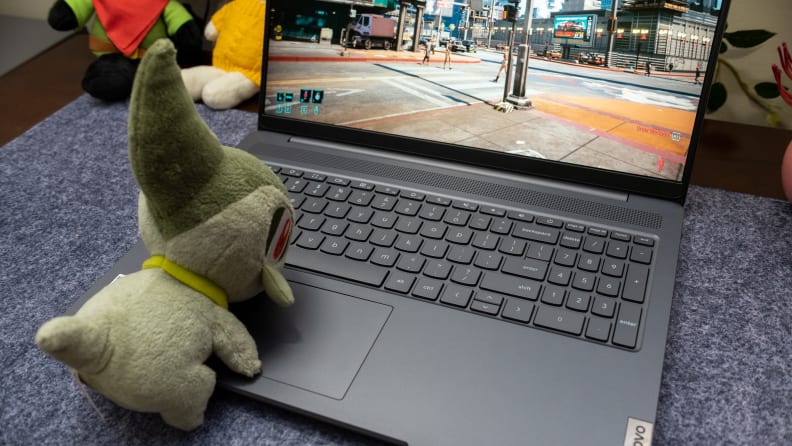
Credit:
Reviewed / Adrien Ramirez
This Chromebook’s super fast Wi-Fi makes for a smooth experience.
The IdeaPad Gaming Chromebook’s 12th gen Intel Core i5 processor comes equipped with Wi-Fi 6E, one of the fastest modern Wi-Fi standards that can compete with Ethernet’s download speeds.
When I tested the Wi-Fi speeds one room apart from the router, the Chromebook reported 310 Mbps download speeds and 10ms of latency (we have Gigabit Wi-Fi). While it’s not Wi-Fi 6E’s full bandwidth capacity, it’s still fast, and you lose some speed when connecting to the Internet over Wi-Fi anyway. The latency is the most important part here; if I’m connected in a peer-to-peer network with my other devices, I feel virtually no latency between the Chromebook and the other devices.
While cloud gaming services don’t have the near-absent latency of local gaming, it was still low enough on the Ideapad Gaming Chromebook to make cloud gaming a smooth experience. We measured the latency on GeForce Now by filming both the laptop display and a wired gaming mouse at slow motion (240 fps). Then we counted the frames between the initial click and the result of the click on-screen to extrapolate the total latency in milliseconds.
Testing near Boston, Massachusetts, both Shadow of the Tomb Raider and Destiny 2 had a delay of 70ms between action and result, which feels snappy enough for the game’s single-player campaign modes even in the heat of battle—It’s a bit more difficult to play through the latency during an online campaign, though.
By comparison, both games had 5ms latency when locally installed on one of our benchmarking desktops with an AMD Ryzen 9 7950X processor, AMD Radeon RX 7900 XTX graphics card, 32GB DDR5-5200 RAM, and Wi-Fi 6E. Both games were set to maxed-out 4K graphics with no framerate cap while the GeForce Now sessions ran at maxed-out 1440p settings and up to 120fps.
Snappy hardware

Credit:
Reviewed / Adrien Ramirez
Overall the fast processor can handle most tasks.
But that internet speed doesn’t mean much if the processor itself cannot handle a lot of data. The Intel Core i5-1235U processor is a snappy one, scoring 1425 points in the Geekbench 5 single-core benchmark, which is about as fast as the Windows-based HP Envy x360 15 we loved for its performance-to-price ratio. Simpler tasks that don’t need a lot of processing power, such as browsing the web or writing a paper, will be a breeze. But programs that need a lot of processing power will be sluggish.
The Intel Core i5-1235U has ten cores, but only two are performance cores—that means it’s great at multitasking with smaller stuff like Netflix or Spotify, but resource-heavy tasks will struggle a lot bit on the two performance cores. Unfortunately, gaming is one such task. Genshin Impact couldn’t run on this Chromebook natively, and its Geekbench 5 multicore score of 5402 points reflects that.
The HP Envy x360 15’s Ryzen 5 processor scored over a thousand points more at 6409 points, but it pales to the Acer Chromebook 516 GE’s 7874 points (its Intel Core i5-1240P processor has two more performance cores than the Core i5-1235U). For a Chromebook, it’s not such a big issue, since they’re primarily devices for web-based activities, and its lightweight processor helps launch tougher mobile apps Clip Studio Paint or Autodesk Fusion 360 quickly.
Crisp display
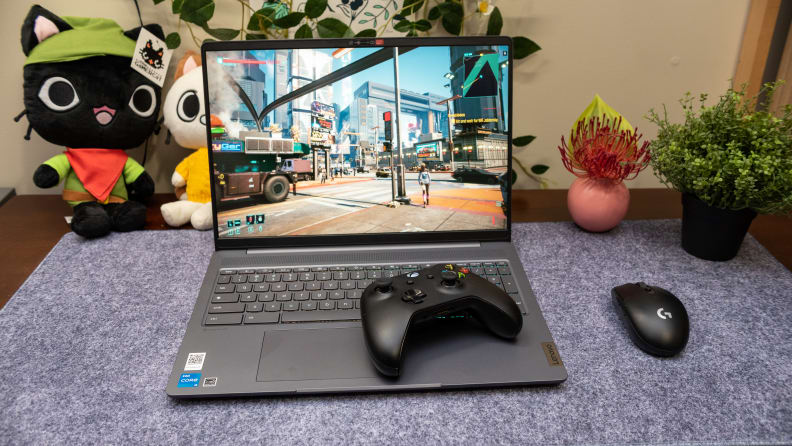
Credit:
Reviewed / Adrien Ramirez
Expect bright, clear images and stellar streaming quality.
The display is one of the better ones we’ve seen in Chromebooks and budget Windows laptops, especially for the $600 price tag. The 2560 x 1600p display runs at 120Hz and is rated up to 350 nits of brightness. Text looks incredibly smooth and the image is bright in a well-lit room. The colors are vivid as well thanks to the full sRGB color gamut coverage. (Many laptops at this price hover between 60% and 80% coverage.)
The IdeaPad Gaming Chromebook is a great device if you spend a lot of time watching videos. Gaming is a little trickier—yes, it can play games at 120 fps, but its processor is not powerful enough to run those games natively at its default resolution, and most cloud gaming services cap framerate at 60 fps.
Of the major cloud gaming platforms, GeForce Now is the only one that runs natively on ChromeOS at the moment—and it runs beautifully on this Chromebook. Lenovo specifically worked with Nvidia to make a laptop that could actually run GeForce Now with as little latency and as much bandwidth as possible.
The streaming quality is stellar even with higher-bandwidth games like Cyberpunk 2077. GeForce Now delivers on its QHD 120 fps promise and its relatively low latency makes it feel much closer to a native gaming experience compared to other cloud gaming platforms.
Good software bundle
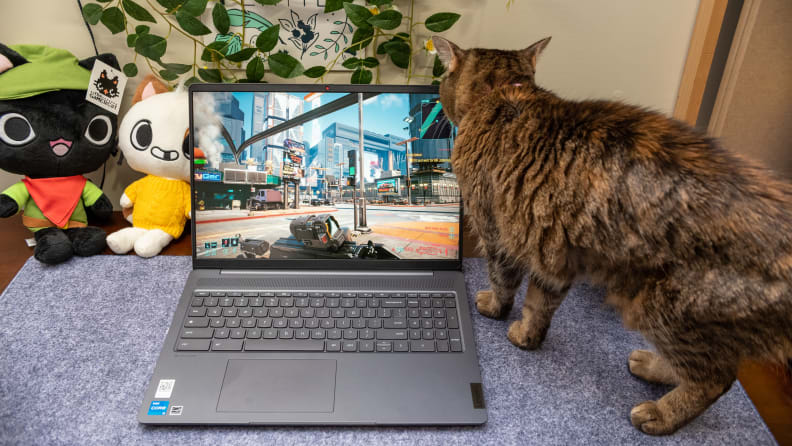
Credit:
Reviewed / Adrien Ramirez
Free trials of Nvidia GeForce Now and Amazon Luna are just some of the bundles that come with the laptop.
Since the IdeaPad Gaming Chromebook is all about providing a great cloud gaming experience, it’s great that Lenovo bundles it with free trials of some of the most popular services. Three free months of Nvidia GeForce Now and Amazon Luna come bundled with the Chromebook, as does Clip Studio Paint, Infinite Paint, and Adobe Lightroom.
Because this Chromebook has a 120Hz 1600p panel, you can stream games from GeForce Now at that resolution and frame rate—something that usually requires a powerful graphics card and a pricey monitor.
Xbox cloud gaming (via the Xbox Game Pass app) does not come preloaded onto the laptop, but you can easily install it from the Play Store. If you have your own gaming PC, you can remotely connect to it with Parsec, Moonlight, or Steam remote play, too. However, I did have trouble streaming with Parsec and Moonlight due to issues with the software (the same issues persisted across ChromeOS, MacOS, and Windows during testing).
What we don’t like
Not really a “gaming” Chromebook

Credit:
Reviewed / Adrien Ramirez
There’s not much here to earn this laptop any specific gaming bona fides.
The IdeaPad Gaming Chromebook is an excellent Chromebook, but is it an excellent gaming machine? There’s not a lot that sets it apart from a good non-gaming Chromebook, aside from the display resolution and refresh rate. It doesn’t have a discrete graphics card to run native Android and ChromeOS games at higher graphics settings. It also lacks an Ethernet port, and while this Chromebook has the best available Wi-Fi adapter, using an Ethernet port for cloud gaming ensures consistent speeds and a stable connection.
Aesthetically, the only “gamer” feature is the adjustable RGB backlighting for the keyboard. If it weren’t explicitly called a Gaming Chromebook on the product page, it would be hard to guess this is anything but a productivity laptop.
You’re limited by your gaming service
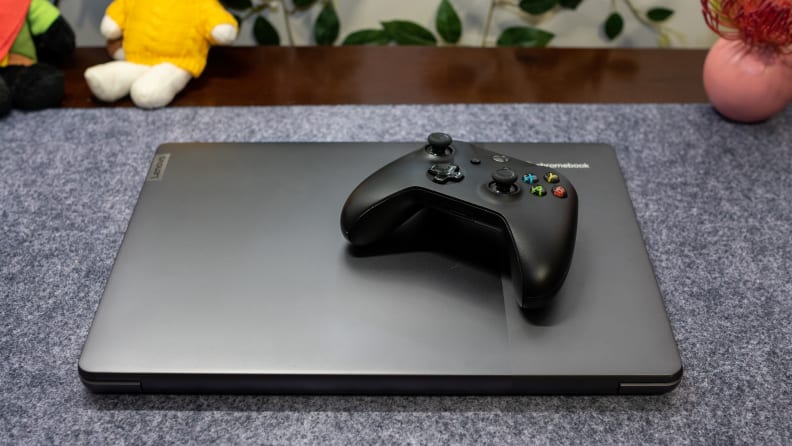
Credit:
Reviewed / Adrien Ramirez
This laptop’s effectiveness as a gaming device hinges on subscription to a service.
Because this laptop is designed around the assumption someone will use it for cloud gaming, most of its processing power and features are dedicated to ensuring a snappy, seamless Internet connection. If you don’t have a fast wireless Internet connection at home, you won’t see any benefit to this laptop’s Wi-Fi 6E connectivity. Similarly, you need a subscription to a service like Nvidia GeForce Now or Xbox Cloud Gaming.
This isn’t a con of the laptop so much as it is a shortcoming of the concept of a cloud gaming notebook: the hardware is capable of providing a fast connection, but that hardware is useless if you don’t have consistent access to the cloud. It’s also not the only cloud gaming device out there. The Logitech G Cloud, Aya Neo Air, and Razer Edge are all excellent handheld consoles that not only connect to cloud gaming services but also offer a form factor that’s explicitly suited for controlling game inputs. Of course, you can also access cloud gaming on a normal Chromebook, or on a Windows or Mac laptop.
Android and Chrome games are shoved to the side

Credit:
Reviewed / Adrien Ramirez
Shortcomings in graphics power and mobile app compatibility limit Android and Chrome game playability.
Emphasizing cloud gaming services on a device with integrated graphics makes sense; users can take advantage of powerful machines remotely instead of having to lug around a chunky gaming laptop. However, a Chromebook has an advantage over a plain ol’ Windows or MacOS laptop: it runs ChromeOS, which means it can run a lot of Android games natively. But it can’t take advantage of that precious display with its current graphics power.
The IdeaPad Gaming Chromebook doesn’t do much in the way of mobile app compatibility, either. Many games available for Android, such as Fortnite, Civilization 6, and Minecraft, aren’t supported by ChromeOS, and only some Chromebooks have access to the Play Store. This Chromebook has Play Store access, and it can run some Android apps such as Parsec and Genshin Impact, but there are many Android apps that aren’t compatible.
Should you buy it?
Maybe, it’s a great Chromebook at the mercy of cloud gaming platforms

Credit:
Reviewed / Adrien Ramirez
This is a stalwart product with nothing to set it apart as an excellent gaming device.
There’s nothing wrong with the Lenovo IdeaPad Gaming Chromebook—it’s classy, sturdily built, reasonably fast, has a great display, and is generally a joy to use. As a Chromebook, it’s definitely one of the best out there. As a gaming device, however, nothing sets it apart from the competition beyond RGB keyboard backlighting and a 120Hz display.
Your gaming experience will depend on your internet connection and your cloud gaming service. It doesn’t have any sort of features that would make it inherently easier to game, nor does it have the horsepower to natively run Android and ChromeOS games better than other Chromebooks. At the end of the day, it’s still just a regular Chromebook, albeit a very good one.
If you’re looking for a portable gaming device, you have better options. For cloud gaming, the Logitech G Cloud gaming handheld, the Aya Neo Air, and the Steam Deck both offer a phenomenal form factor that makes it convenient to game just about anywhere.
If you’re more interested in gaming on a budget, there are quite a few gaming laptops that offer much better graphics performance—the HP Victus 16 and the Acer Nitro 5 are both about as cheap as the IdeaPad Gaming Chromebook, and their discrete graphics cards will let you run games natively at 1080p resolution with high frame rates (although not as high as GeForce Now’s 120fps on the IdeaPad Gaming Chromebook). The downside is that they’re not as sophisticated as the IdeaPad Gaming Chromebook when it comes to weight, thickness, or battery life.
If Lenovo had sold this as the Lenovo IdeaPad Chromebook, it would deserve a lot of praise and little criticism. However, the reality is that too much of the gaming experience is dictated by factors beyond the Chromebook itself.
The product experts at Reviewed have all your shopping needs covered. Follow Reviewed on Facebook, Twitter, Instagram, TikTok, or Flipboard for the latest deals, product reviews, and more.
Prices were accurate at the time this article was published but may change over time.
Meet the tester
Adrien is a staff writer for Reviewed, mainly focused on reviewing laptops and other consumer tech. During his free time, he’s usually wandering around Hyrule.
Checking our work.
Our team is here for one purpose: to help you buy the best stuff and love what you own. Our writers, editors, and lab technicians obsess over the products we cover to make sure you’re confident and satisfied. Have a different opinion about something we recommend? Email us and we’ll compare notes.











